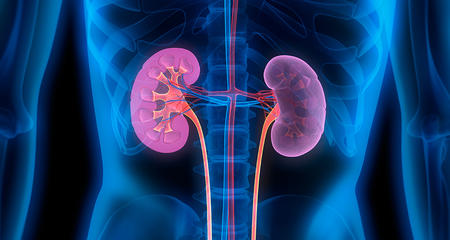Acromegaly is a hormonal disorder that occurs when the pituitary gland produces too much growth hormone in the body. This is not a common disorder and physical changes gradually occur so it can take a long time to recognize. If acromegaly is not treated, it can lead to serious illness and can become life threatening.
Causes of Acromegaly
Acromegaly is the result of the overproduction of human growth hormone (HRH) by the pituitary gland. When growth hormone (GH) is secreted it prompts the liver to produce insulin-like growth factor-1 (IGF-1), a hormone. The IGF-1 triggers bone growth and the growth of other tissues.
In adults, the most common cause of overproduction of growth hormone is a tumor.
- Pituitary tumor. Acromegaly is almost always caused by a benign or noncancerous pituitary tumor. The tumor secretes growth hormone in excessive amounts.
- Nonpituitary tumor. In very rare cases, people with acromegaly, have tumors in other areas of the body that can cause this disorder. The tumors can be found in areas such as the liver or pancreas. Sometimes the tumors can produce growth hormones or they can produce another hormone called growth hormone-releasing hormone which stimulates the production of growth hormone in the pituitary gland.
Acromegaly Symptoms
The overproduction of growth hormone can cause the enlargement of physical characteristics, joints and organs. This disorder can take a long time to diagnose and sometimes it is only noticed by comparing old pictures with new ones.
Acromegaly may cause some of the following signs and symptoms but each person is unique and they can vary:
- Enlarged features of the face
- Growth in hands and feet (noted by increase ring or shoe size)
- Thickened, coarse and oily skin
- Skin tags and moles
- Muscle weakness and fatigue
- Enlarged sinuses and vocal cords causing a deeper voice
- Snoring, which could indicate sleep apnea
- Headaches
- Vision impairment
- Tongue enlargement
- Joint pain and mobility limitations
- Irregular menstrual cycles for women
- Sexual dysfunction in men, such as erectile dysfunction
- Decreased libido
- Organ enlargement
If acromegaly progresses and is not treated it can create other health complications that may include the following:
- High blood pressure
- Heart enlargement, cardiovascular conditions
- Diabetes
- Osteoarthritis — premature early arthritis
- Goiter
- Sleep disorders, such as sleep apnea
- Carpal tunnel syndrome
- Compression of the spinal cord
- Loss of vision
Diagnosing Acromegaly
Schedule a clinic appointment to obtain a medical history and perform a physical examination. The provider may make the following recommendations.
- IGF-1 blood levels. This blood level can diagnosis acromegaly in the majority of cases. An elevation in the levels may suggest acromegaly.
- Glucose suppression test. This test is a more sensitive and definitive way of verifying the diagnosis of acromegaly if the IGF-1 level is borderline. For this test, you will need to fast. A baseline growth hormone level is obtained then you drink a sugar preparation (glucose) and levels are then obtained again. The ingestion of glucose normally decreases the levels of growth hormone but for people with acromegaly, the levels will remain high.
- Magnetic resonance imaging (MRI). Once there is biochemical evidence of growth hormone excess then a MRI is done to help locate and determine the size of a tumor in the pituitary gland. If a tumor is not seen, your provider may search for non-pituitary tumors as the reason for the elevated growth hormone levels.
Acromegaly Treatment
The focus of treatment is on decreasing growth hormone production as well as minimizing the negative effects the tumor has on the pituitary gland and the surrounding structures.
Medications
The medications are used to block the action or lower the production of growth hormone and lower IGF-1 levels.
- Octreotide (Sandostatin) and Lanreotide (Somatuline Depot) are somatostatin analogues that disrupt the excessive secretion and rapidly decrease the growth hormone and IGF-1 levels and can also decrease tumor size. This medication is administered as a monthly injection into a muscle in the buttock.
- Cabergoline or bromocriptine are dopamine agonists that lower the growth hormone and IGF-1 levels but are not very effective with this tumor type. This medication is given by mouth in tablet form.
- Pegvisomant is a growth hormone antagonist that blocks the growth hormone effects on body tissue. This medication can be useful for people who have not had success with other medications. It is administered daily in the form of an injection. Pegvisomant can relieve some of the symptoms by lowering the IGF-1 levels but will not lower growth hormone levels or decrease the size of the tumor.
Surgery
A neurosurgeon can effectively remove a majority of pituitary tumors by using a transsphenoidal approach for surgery if the tumor has become too large. In this surgery, the surgeon enters through the nose to remove the tumor from the pituitary gland. Removing the tumor can normalize the production of growth hormone and eliminate the negative effects of tumor pressure on the surrounding areas.
Radiation Therapy
Radiation may be recommended by your provider if there is remaining tumor tissue after surgery. Radiation therapy is used to destroy the tumor cells and over time slowly decrease the growth hormone levels.
- Gamma Knife therapy is a procedure for delivering a single focused radiation therapy to select pituitary tumors.
- External radiation therapy is also used to deliver radiation therapy to pituitary tumors but is done in multiple small fractions over 6 weeks.
Blogs, Patient Stories, Videos and Classes





